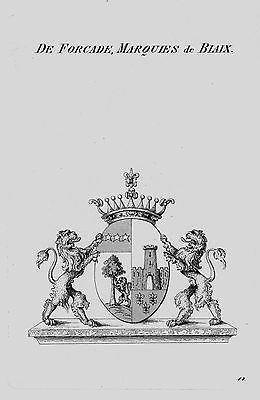Name Friedrich von | ||
 | ||
Friedrich Wilhelm von Forcade de Biaix, aka Frideric Guillaume de Forcade (* 23 July 1728, Berlin; † 2 or 3 September 1778, Frankfurt an der Oder) was a Royal Prussian Colonel, Schwadronschef (German: Rittmeister) of the 2nd Grenadier Company in the 24th Prussian Infantry Regiment, recipient of the Kingdom of Prussia's highest military order of merit for heroism, Knight of the Order of Pour le Mérite (1774), Commandant of Frankfurt/Oder, and Presbyter of the French congregation of Frankfurt/Oder.
Contents
He was the eldest son, of Royal Prussian Lieutenant General Friedrich Wilhelm Quirin von Forcade de Biaix, one of King Frederick the Great's most active and most treasured officers.
He was presented for baptism on 23 August 1728 by none less than His Majesty the King, Frederick William I of Prussia and Major General Jean de Forcade de Biaix, the paternal grandfather, as his godfathers. Also present at the baptism were Her Royal Highness the Princess Johanna Charlotte von Anhalt-Dessau, Margrave Douairière and widow of Margrave Philippe, Anna Sophia von Treskow, Countess von Wartensleben, second wife of General Field Marshal Alexander Hermann Count von Wartensleben, and Susan de Pelissier, wife of Major General Louis de Montolieu de Saint-Hyppolite, the maternal grandmother, all of whom together his godmothers.
Military career
He followed the military tradition of his family and fought in the First Silesian War, the Second Silesian War and the Seven Years' War, climbing to the rank of Colonel.
Coat of arms
The family motto of the Prussian branch is "In Virtute Pertinax".
Coat of arms: An escutcheon with the field divided into four parts. Left half: argent tincture, a gules lion holding a sinople eradicated oak tree between its paws; azure tincture charged with three or mullets; Right half: a gules castle with three towers on an argent tincture; sinople tincture charged with three argent roses below it. A Grafenkrone (Count's coronet) as helmut on top of the escutcheon, crested with a or fleur-de-lis. Two or lions supporting the escutcheon. Motto: "In Virtute Pertinax".
Heraldic symbolism: The lion symbolizes courage; the eradicated oak tree symbolizes strength and endurance; the towers are symbols of defense and of individual fortitude; the mullets (5-star) symbolizes divine quality bestowed by god; the rose is a symbol of hope and joy; the fleur-de-lis is the floral emblem of France; the coronet is a symbol of victory, sovereignty and empire. A Count's coronet to demonstrate rank and because the family originally served the counts of Foix and Béarn during the English Wars in the Middle Ages.
Parents
His father was Friedrich Wilhelm Quirin von Forcade de Biaix (1698-1729), one of King Frederick the Great's most active and most treasured officers. Twice wounded and left for dead on the battlefield, he was Regimentschef of the 23rd Prussian Infantry Regiment, recipient of the Kingdom of Prussia's highest military order of merit for heroism, Knight of the Order of Pour le Mérite, Knight of the Order of the Black Eagle, Canon of Havelberg, Castellan of Neuenrade in the County of Mark, [ord Seneschal of Zinna, President of the Ober-Collegium Sanitatis in Berlin and Lieutenant governor of Breslau. He married in 1727 at the French Cathedral in Berlin with Marie de Montolieu, Baronne de St.-Hippolyte aka Maria von Montaulieu, Freiin von St.-Hippolyte (1709-1767), daughter of Sardinian and Prussian Major General Louis de Montolieu, Baron de St.-Hippolyte († 1738, Berlin), also a Huguenot exile.
Marriage
Friedrich Wilhelm von Forcade de Biaix never married.
